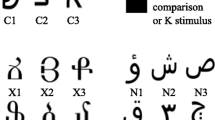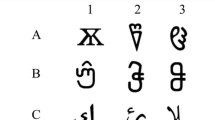Abstract
Previous studies comparing groups of subjects have indicated differential probabilities of stimulus equivalence outcome as a function of training structures. One-to-Many (OTM) and Many-to-One (MTO) training structures seem to produce positive outcomes on tests for stimulus equivalence more often than a Linear Series (LS) training structure does. One of the predictions from the discrimination analysis of R. R. Saunders and Green (1999) is that the differences in outcome between training structures should increase with number of class members. The purpose of the present experiment was to replicate and expand earlier findings on the effect of training structures and the stimulus equivalence outcome in a single-subject design. We wanted to compare the stimulus equivalence outcome in three 3-member classes to the outcome in three 4-member classes. In addition, we included all trial types in the tests and also changed the density of feedback before testing. The results from the current study replicated some earlier findings and showed that OTM gave a slightly better outcome on the stimulus equivalence test than MTO, and that both gave better outcome than LS. Thus, we did not find that MTO was superior to OTM with increasing number of members in each class. Reaction time data also replicated earlier findings that showed an increase from baseline to testing, and a more pronounced increase in reaction time on equivalence than symmetry trials. Differential procedural issues and some contingencies that could be important in understanding the results are discussed.
Similar content being viewed by others
References
ARNTZEN, E. (2004). Probability of equivalence formation: Familiar stimuli and training sequence. The Psychological Record, 54, 275–291.
ARNTZEN, E. (2007, March). Some procedural variables that might influence equivalence class formation. Paper presented at the annual convention of the Texas Association for Behavior Analysis, Dallas, Tx.
ARNTZEN, E., & HOLTH, P. (1997). Probability of stimulus equivalence as a function of training design. The Psychological Record, 47, 309–320.
ARNTZEN, E., & HOLTH, P. (2000a). Differential probabilities of equivalence outcome in individual subjects as a function of training structure. The Psychological Record, 50, 603–628.
ARNTZEN, E., & HOLTH, P. (2000b). Probability of stimulus equivalence as a function of class size vs. number of classes. The Psychological Record, 50, 79–104.
Arntzen, E., & Lian, T. (in press). Trained and derived relations with pictures as nodes. The Psychological Record.
ARNTZEN, E., & AIDYA, M. (2008). The effect of baseline training structure on equivalence class formation in children. Experimental Analysis of Human Behavior Bulletin, 29, 1–8.
BARNES, D. (1994). Stimulus equivalence and relational frame theory. The Psychological Record, 44, 91–124.
BENTALL, R. P., JONES, R. M., & DICKINS, D. W. (1999). Errors and response latencies as a function of nodal distance in 5-member equivalence classes. The Psychological Record, 49, 93–115.
CARRIGAN, P. F., & SIDMAN, M. (1992). Conditional discrimination and equivalence relations: A theoretical analysis of control by negative stimuli. Journal of the Experimental Analysis of Behavior, 58, 183–204.
DYMOND, S., & REHFELDT, R. A. (2001). Supplemental measures and derived stimulus relations. Experimental Analysis of Human Behavior Bulletin, 19, 8–12.
EILIFSEN, C., & ARNTZEN, E. (2009). On the role of trial types in tests for stimulus equivalence. European Journal of Behavior Analysis, 10, 187–202.
FIELDS, L., ADAMS, B. J., NEWMAN, S., & ERHAVE, T. (1990). The effects of nodality on the formation of equivalence classes. Journal of the Experimental Analysis of Behavior, 53, 345–358.
FIELDS, L., HOBBIE-REEVE, S. A., ADAMS, B. J., & REEVE, K. F. (1999). Effects of training directionality and class size on equivalence class formation by adults. The Psychological Record, 49, 703–724.
FIELDS, L., LANDON-JIMENEZ, D. V., BUFFINGTON, D. M., & ADAMS, B. J. (1995). Maintained nodal-distance effects in equivalence classes. Journal of the Experimental Analysis of Behavior, 64, 129–145.
GREEN, G., & SAUNDERS, R. R. (1998). Stimulus equivalence. In K. A. LATTAL & M. PERONE (Eds.), Handbook of research methods in human operant behavior (pp. 229–262). New York: Plenum Press.
HOLTH, P., & ARNTZEN, E. (1998). Stimulus familiarity and the delayed emergence of stimulus equivalence or consistent nonequivalence. The Psychological Record, 48, 81–110.
HOLTH, P., & ARNTZEN, E. (2000). Reaction times and the emergence of class consistent responding: A case for precurrent responding? The Psychological Record, 50, 305–338.
HOVE, O. (2003). Differential probability of equivalence class formation following a one-to-many versus a many-to-one training structure. The Psychological Record, 53(4), 617–634.
IMAM, A. A. (2006). Experimental control of nodality via equal presentations of conditional discriminations in different equivalence protocols under speed and no-speed conditions. Journal of the Experimental Analysis of Behavior, 85, 107–124.
JOHNSON, C., & Sidman, M. (1993). Conditional discrimination and equivalence relations: Control by negative stimuli. Journal of the Experimental Analysis of Behavior, 59, 333–347.
KENNEDY, C. H. (1991). Equivalence class formation influenced by the number of nodes separating stimuli. Behavioural Processes, 24, 219–245.
SAUNDERS, K. J., SAUNDERS, R. R., WILLIAMS, D. C., & SPRADLIN, J. E. (1993). An interaction of instructions and training design on stimulus class formation: Extending the analysis of equivalence. The Psychological Record, 43, 725–744.
SAUNDERS, R. R., CHANEY, L., & MARQUIS, J. G. (2005). Equivalence class establishment with two-, three-, and four-choice matching to sample by senior citizens. The Psychological Record, 55, 539–559.
SAUNDERS, R. R., DRAKE, K. M., & SPRADLIN, J. E. (1999). Equivalence class establishment, expansion, and modification in preschool children. Journal of the Experimental Analysis of Behavior, 71, 195–214.
SAUNDERS, R. R., & GREEN, G. (1999). A discrimination analysis of training-structure effects on stimulus equivalence outcomes. Journal of the Experimental Analysis of Behavior, 72, 117–137.
SAUNDERS, R. R., & MCENTEE, J. E. (2004). Increasing the probability of stimulus equivalence with adults with mild mental retardation. The Psychological Record, 54(3), 423–435.
SAUNDERS, R. R., WACHTER, J. A., & SPRADLIN, J. E. (1988). Establishing auditory stimulus control over an eight-member equivalence class via conditional discrimination procedure. Journal of the Experimental Analysis of Behavior, 49, 95–115.
SIDMAN, M. (1994). Equivalence relations and behavior: A research story. Boston: Authors Cooperative.
SIDMAN, M., & TAILBY, W. (1982). Conditional discrimination vs. matching to sample: An expansion of the testing paradigm. Journal of the Experimental Analysis of Behavior, 37, 5–22.
SPENCER, T. J., & CHASE, P. N. (1996). Speed analysis of stimulus equivalence. Journal of the Experimental Analysis of Behavior, 65, 643–659.
SPRADLIN, J. E., & Saunders, R. R. (1986). The development of stimulus classes using match-to-sample procedures: Sample classification versus comparison classification. Analysis and Intervention in Developmental Disabilities, 6, 41–58.
WILSON, K. M., & MILAN, M. A. (1995). Age differences in the formation of equivalence classes. Journals of Gerontology Series B: Psychological Sciences and Social Sciences, 50, 212–218.
WULFERT, E., & HAYES, S. C. (1988). Transfer of conditional ordering response through conditional equivalence classes. Journal of the Experimental Analysis of Behavior, 50, 125–144.
Author information
Authors and Affiliations
Corresponding author
Rights and permissions
About this article
Cite this article
Arntzen, E., Grondahl, T. & Eilifsen, C. The Effects of Different Training Structures in the Establishment of Conditional Discriminations and Subsequent Performance on Tests for Stimulus Equivalence. Psychol Rec 60, 437–461 (2010). https://doi.org/10.1007/BF03395720
Published:
Issue Date:
DOI: https://doi.org/10.1007/BF03395720




